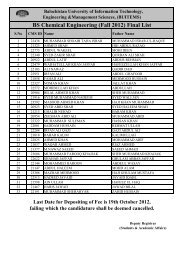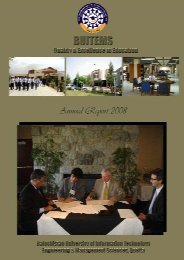BUITEMS
Research Journal - buitems
Research Journal - buitems
- No tags were found...
You also want an ePaper? Increase the reach of your titles
YUMPU automatically turns print PDFs into web optimized ePapers that Google loves.
<strong>BUITEMS</strong><br />
Quality & Excellence in Education<br />
Introducing Lane Based Sectoring for Routing in VANETs<br />
car and necessary safety following distance many<br />
potential time slot colliders are still present in<br />
adjacent lanes. Considering the effect of lanes<br />
in VANETs forms the core of this work.<br />
This paper aims to uncover the role of lanes<br />
in VANET communication. With road widths<br />
fastly nearing 100 meters (more than ten<br />
lanes each direction) (Turnbull 2003), it<br />
has become indispensable to consider the<br />
effect of road width or more specifically<br />
lanes while designing message propagation<br />
al- gorithms for VANETs. This work primarily<br />
considers dense urban traffic environment where<br />
traffic in each lane behaves like train trails with<br />
constant speeds. The proposed technique is<br />
suggested to be incorporated with methods<br />
for regular traffic using the currently probed<br />
vehicle density learning mechanism. To the<br />
best of our knowledge, this is the first work that<br />
considers the worst case rush hour traffic,<br />
whereas the previous works deal normal urban<br />
traffic as the extreme case. The use of the<br />
prevailing Differential Geographic Positioning<br />
System (DGPS) is assumed to determine<br />
accurate vehicle location. The aforementioned<br />
transmission range of a message originator is<br />
finely dissected both length and width-wise<br />
using distance and lanes respectively, forming<br />
a grid like structure with each block containing<br />
a single vehicle at most. Unique backoff values<br />
are assigned to each block ensuring only one<br />
vehicle in the furthest range forwards the<br />
message. Long contention window as a result<br />
of fine dissection may suggest high transmission<br />
delay, however, in dense traffic there is<br />
always a forwarding vehicle present in the<br />
furthest range that transmits with minimal<br />
backoff (i.e. transmission in the beginning of<br />
the window), making the length of the window<br />
ineffectual on delay. Additionally, since the<br />
overhead delay of message retransmission due<br />
to forwarding collisions is reduced, the over<br />
all end to end message propagation time is<br />
remarkably minimized.<br />
The proposed idea is studied using thorough<br />
simulations performed in network simulator-3<br />
(ns-3) Considerable reduction in rebroadcast<br />
collisions is achieved by using the grid based<br />
technique and the total collision occurrence<br />
is contained to below 3% in the worst case,<br />
while the message forwarding delay for each<br />
hop is improved by 9 ms over the existing<br />
sectoring technique. The important contributions<br />
of this work are: reducing packet collisions<br />
due to visible (non-hidden) nodes to near<br />
zero by using the grid based unique backoff<br />
value assignment, improved propagation delay<br />
through instant and collision-free forwarding<br />
of the furthest node, greater coverage by<br />
ensuring the furthest node as the next<br />
forwarder, and bringing to light the hitherto<br />
disregarded factor of road width to the<br />
attention of VANET research community. The<br />
remaining of this paper is organized as<br />
follows. Section II gives a brief idea of the<br />
significance of road width in VANETs in related<br />
literature. Section III details the proposed<br />
technique with theoretical analysis. Section IV<br />
presents the ns-3 simulation environment,<br />
results and their discussion. Conclusion with<br />
a discussion on future work is given in<br />
Section V.<br />
Road Width in Vehicular<br />
Communication<br />
Road topology is one of the critical foundation<br />
elements considered while designing<br />
communication mechanisms for VANETs. Some<br />
of the important topology factors considered in<br />
hitherto VANET literature include vehicle<br />
density, vehicle speed, headway distance, road<br />
side clutter (for path loss cal- culation), while<br />
the road geometry is assumed either entirely<br />
linear or with the inclusion of intersections<br />
( F e s o l o e t a l . , 2 0 0 6 , L i e t a l . , 2 0 0 9 ,<br />
B l a s z c z y s z y n e t a l . , 2 0 0 9 , K o r k m a z e t<br />
a l . , 2 0 0 4 , X u e t a l . , 2 0 0 4 ) consider road<br />
width, however, their consideration is limited to<br />
its effect on vehicle density i.e. geographical<br />
separation of lanes is not considered and instead<br />
parallel vehicles in different lanes are assumed<br />
to be at the same location. Road width is also<br />
neglected in VANET mobility pattern generator<br />
tools (Krajzewicz and Rossel, 2011, Haerri et<br />
al., 2006, Traffic & Network simulation, 2011),<br />
where multiple lanes only account for density<br />
while their geographical separation is still<br />
ignored. The exponential increase of vehicles on<br />
the road has resulted in the ever increasing road<br />
widths to maintain smooth flow of traffic.<br />
Consequently, the average width of busy roads<br />
in a metropolis has become above six lanes each<br />
direction (Bauer et al., 2004). I-10 East downtown<br />
Houston is a compelling example of the<br />
significance of road width where the road is as<br />
80
















